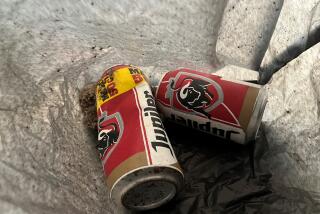Goliath-size flap over David
- Share via
FLORENCE, Italy — The left hand, forearm and wrist were fractured in a riot and a toe was angrily smashed with a hammer. The chest looks as if grimy sweat hasn’t been cleaned away in more than a century.
Still, the imposing physique attracts 1.2 million admirers each year, and woe to anyone who messes with Michelangelo’s masterpiece, David, which stands aloofly on a pedestal in the Accademia Gallery in the heart of this Renaissance city.
That, in somewhat crude terms, is the concern essentially underlying the art world’s latest flap, as Italy agonizes over how to preserve its priceless cultural icon.
In 2004, it will be 500 years since the 13.5-foot-high statue depicting the courageous, naked young biblical hero was unveiled in Piazza della Signoria, the square that remains Florence’s lifeblood.
The block of marble itself is even older. Badly veined and pitted, the hunk of rock had languished for decades in the courtyard of the city’s cathedral, thwarting other sculptors who eventually cast aside their chisels in frustration before Michelangelo triumphantly embraced the challenge.
Now, one of Italy’s leading Renaissance art restorers has thrown down her tools -- chamois cloth, silky soft brush, cotton swabs and an eraser -- in a spat with other experts over how to clean David.
Rallying to restorer Agnese Parronchi’s side is James Beck, a Columbia University art historian, who has challenged some of the most ambitious restorations of the past few decades, including that of Michelangelo’s frescoed ceiling in the Sistine Chapel, which emerged as a palette of shockingly vibrant colors after centuries of sober tones.
Parronchi said she quit this spring, after months of tedious examination of the statue, when a committee of experts, including the Accademia’s director, rejected her “dry” cleaning method.
“It was the first time I was given a directive,” said Parronchi, who has spent 20 years restoring such monuments as the Medici Tombs. “I was incredulous.”
The committee told her she should apply poultices of distilled water to remove the dirt.
Poultices are a kind of compress applied to a surface to draw away dirt or other pollutants. A widely accepted practice in restoration, the poultices, soaked in a solution, work much the way a compress would when pressed on flesh to, say, reduce the swelling or draw out the poisons in a bee sting.
“Dirt is never uniform, so intervening in a uniform way doesn’t make sense,” Parronchi said. “You risk ruining the balance.”
She added that she didn’t want to be the one making mistakes on a masterpiece.
Accademia director Franca Falletti said the poultices will be carefully applied for measured amounts of time, depending on the degree of dirt.
An art historian, Falletti contended that Parronchi’s method risked pushing some of the dirt underneath the surface.
After the last of the tourists had left one evening, Falletti’s footsteps resounded in the air-conditioned, cavernous room where David stands, his sling casually thrown over a shoulder.
She stopped before other Michelangelo sculptures, ignored by many tourists in their rush to gawk at David. Michelangelo’s Prisoners, haunting figures half-imprisoned in stone, were restored with the poultice method to not one protest, Falletti said.
“When you work on David, there are polemics,” she said with a knowing sigh.
The restorer of the Prisoners has been asked to replace Parronchi and carry out “a light cleaning to render the statue more legible,” Falletti said.
“Legible for whom?” snapped back Beck, interviewed by telephone in New York. “Legible to the simple tourist [in town] for the average 36 hours, or legible for the serious art lover or expert?”
The professor called Parronchi’s approach “respectful” and said he was coming to Italy to push for an independent commission to decide how David should be cleaned.
A Dutch nonprofit foundation is paying for the David project.
More to Read
The biggest entertainment stories
Get our big stories about Hollywood, film, television, music, arts, culture and more right in your inbox as soon as they publish.
You may occasionally receive promotional content from the Los Angeles Times.










